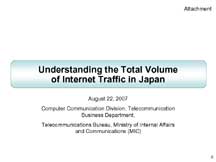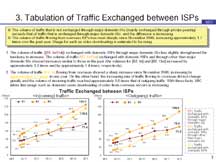Fascinating Analysis of Internet Traffic in Japan
 First - go read this pdf of an August 22, 2007 PowerPoint presentation on the Japanese Ministry of Internal Affairs and Communications website.
First - go read this pdf of an August 22, 2007 PowerPoint presentation on the Japanese Ministry of Internal Affairs and Communications website.Impressed? You should be. This is fascinating stuff.
In Japan, FTTH customers get 100Mbps bidirectional service for about the same that US customers are paying for less than 10Mbps downstream (and even less upstream). A day rarely passes that another North American service providers doesn't make a statement about 1Mbps/10Mbps/25Mbps being plenty. Even industry gadfly Om Malik dares to ask "what would you do with 100 megabits/second connection if you had one". More on that later - first let's take a look at this fascinating study and see how the Japanese are utilizing their bandwidth.
The average downstream internet traffic in Japan is over 720Gbps. That's the average, not the peak. Based on the other information in the document, the peak is easily in excess of a Terabit per second. (Other sources report that the median downstream speed per user in Japan is 61Mbps.) This is an increase of 1.4 times in a single year. So while all of those hockey-stick internet drawings of the late 90s may not have been true, there's no leveling off either. This is good news for those of us still in the telecommunications industry.
 The hourly data on slide #3 (labeled #2) is one of the most interesting. Not only has the maximum bandwidth rate on an hourly basis gone up by a factor of 2.4 in 2.5 years, but even lowest bandwidth rate on an hourly basis doubled in 2.5 years. That means that even in the off-peak hours when everyone's supposed to be sleeping, the demand for bandwidth has risen 100%. Of course there are some late-night gaming and "entertainment" numbers in there, but I suspect that what this really shows is that people have developed applications that take advantage of the available bandwidth 24 hours a day. Remote storage, unattended download, network backup (work to home and vice-versa), video time- and place-shifting all become realizable applications when sufficient bandwidth is provided. (I have a colleague who set up a SlingBox in the U.S. and downloads local news and sports to his parents' DVR in Japan. The biggest limitation is the upload speed provided by his US ISP.)
The hourly data on slide #3 (labeled #2) is one of the most interesting. Not only has the maximum bandwidth rate on an hourly basis gone up by a factor of 2.4 in 2.5 years, but even lowest bandwidth rate on an hourly basis doubled in 2.5 years. That means that even in the off-peak hours when everyone's supposed to be sleeping, the demand for bandwidth has risen 100%. Of course there are some late-night gaming and "entertainment" numbers in there, but I suspect that what this really shows is that people have developed applications that take advantage of the available bandwidth 24 hours a day. Remote storage, unattended download, network backup (work to home and vice-versa), video time- and place-shifting all become realizable applications when sufficient bandwidth is provided. (I have a colleague who set up a SlingBox in the U.S. and downloads local news and sports to his parents' DVR in Japan. The biggest limitation is the upload speed provided by his US ISP.)Also fascinating about the hourly data graph is the way that the peaks have sharpened. The ratio between minimum rate in an hour and maximum rate in an hour has increased from 1.8 to about 2.3. This means that more and more people are using their bandwidth in a smaller window. And that window is not the US window around 3-5pm - it's between 9pm and 11pm. In the US, we call that "prime time". Could this possibly mean that Japanese consumers are actually using the internet to watch video? Real video, not the grainy little offerings on YouTube? You betcha! Cable TV isn't nearly as ubiquitous in Japan as it is in the US. Most people get their TV from the airwaves (there are still antennas all over the houses and condos). And the installation instructions for FTTH from NTT includes instructions on how to set up your big screen TV/monitor for streaming video. Also, of course, many people in Japan are at work until 8 or 9 pm, so you wouldn't expect to see a peak at 5. (There are grammar school kids in uniforms walking around Yokohama station at 8pm. Everything's shifted.)
I also like the un-noted fact on the hourly chart that the peaks spread out on the weekends. It's remarkable that the maximum doesn't go down, though. That means that the total demand for content (the area under the curve) is greater on the weekends than during the week. A nation of addicted on-line gamers eating up their free moments fighting dragons ... or a nation of weekend couch-potatoes that are increasingly getting the majority of their content on-line. I'd bet on the latter. [Aside: I'd imagine that US bandwidth trends would be the same if a real, on-demand standard definition, straight to the TV service could reliably be had over our pitiful DSL and cable modem connections.]
 Slide #4 (labeled #3) has another fascinating set of facts. The incoming traffic to Japan has increased 1.7 times in the last year while outgoing traffic has remained relatively static. This implies that, while internet usage and on-line consumption has increased, content generation in Japan has not. That's not a pretty place to be if you're an information-technology based economy. Another interesting question that it raises is around ad placement. If you're trying to reach the Japanese consumer, where do you place your ads? Increasingly, that answer may not be with Japanese websites. Again, not a pretty place to be for Japanese businesses.
Slide #4 (labeled #3) has another fascinating set of facts. The incoming traffic to Japan has increased 1.7 times in the last year while outgoing traffic has remained relatively static. This implies that, while internet usage and on-line consumption has increased, content generation in Japan has not. That's not a pretty place to be if you're an information-technology based economy. Another interesting question that it raises is around ad placement. If you're trying to reach the Japanese consumer, where do you place your ads? Increasingly, that answer may not be with Japanese websites. Again, not a pretty place to be for Japanese businesses.The Japanese model of broadband deployment separates the bandwidth provider from the content provider and ISP. Generally, NTT offers only a big pipe to their customers. The customers get their ISP, VoIP, content, etc. from other providers. One reason that this wholesale model works is because content providers who want the highest speed link to the consumers will also pay for access on the NTT network. However, the numbers in this study show that broadband customers are increasingly looking elsewhere for their content. That will be an interesting trend to follow. [Aside: this should not be an issue in the US, as we provide more content than anyone else in the world ... for better or for worse.]
So, back to the question way up in the second paragraph. What would US consumers do with a 100Mbps connection? The answer right now is probably "not much more than we currently do", and that's because our infrastructure isn't geared to handle it. However, if we did manage to step up the the plate and treat our data infrastructure like our transportation infrastructure and build the highways required to go from 35mph up to 70mph or more, then US consumers would probably use their bandwidth in ways very similar to our Japanese counterparts. In Japan, the applications have followed the bandwidth. Once you can assume that customers have at least 50Mbps to their homes, new services can be offered.
Can you imagine what all those Web 2.0 entrepreneurs could come up with if they could be assured of 100Mbps to prime customers?
Can you imagine what game designers could do with that bandwidth?
Can you imagine what Google - or even Microsoft - could develop that utilizes 100Mbps?
Sure it's a chicken and egg problem. Without the bandwidth the applications don't develop and without the applications the bandwidth providers claim there's no demand. But look at the numbers from Japan. With public policy assistance, the bandwidth came first. The applications - and the utilization of the bandwidth - is following along quickly.
Labels: telecommunications

0 Comments:
Post a Comment
Links to this post:
Create a Link
<< Banana Stew Home